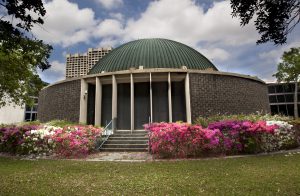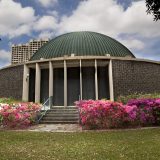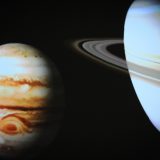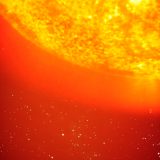
HOUSTON—Planets, stars, meteors, solar systems and entire galaxies zoom past audiences in the Burke Baker Planetarium, as they leave Earth far behind. A fascinating array of films explores the marvels of the universe, and the most dramatic moments on planet Earth. State-of-the-art projection technology and high-resolution video provide vivid, immersive imagery of the wonders of outer space on the Planetarium’s domed screen.
“We focus on presenting emerging technologies in our newest planetarium films, because today’s kids will live in the future,” said Carolyn Sumners, Ed.D., vice president of astronomy for the Houston Museum of Natural Science, “Showing them the fascinating possibilities science can generate excites students about helping to create that future.”
In early 2007, the Burke Baker Planetarium premiered a new projection system that presents films five times brighter and at double the resolution. Capable of displaying twice as many pixels per image, the new system projects the wonders of outer space onto the full dome with amazing clarity. Now, Planetarium audiences explore the secrets of the Sun, and discover the dramatic changes now occurring on distant ice worlds and in the Earth’s polar regions, among other adventures.
In 1998, the Burke Baker Planetarium created the nation’s first full-dome computer-animated planetarium show. Since then, the Planetarium has produced multiple films on a vast range of topics, from deep space to Lucy’s Cradle, The Birth of Wonder (2007), which transports visitors to Africa 3.2 million years ago, and Night of the Titanic (2008), which places viewers on the RMS Titanic during the fateful night of April 14, 1912. As one of the few planetariums in the United States capable of producing such virtual programs, it also distributes these shows to other planetariums around the world.
Since this Houston landmark opened in 1964, millions of visitors have explored the cosmos at the Burke Baker Planetarium. NASA astronauts have used the Planetarium’s realistic star-field projection system to experience three-dimensional flight through space, as well as to practice star-field identification needed to calibrate on-board equipment.
In 2007, the NASA astronauts of flight STS 120 took a large-format fisheye camera into space to capture images that give viewers the experience of being on the Space Station.
Through its inflatable portable Discovery Domes, the Museum also brings the planetarium’s immersive video experiences to over 35,000 area school children each year.
For show times and tickets, visit www.hmns.org or call (713) 639-4629.





